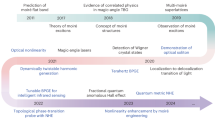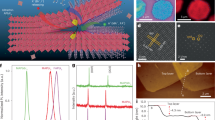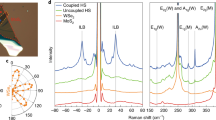Abstract
Studies of moiré systems have explained the effect of superlattice modulations on their properties, demonstrating new correlated phases1. However, most experimental studies have focused on a few layers in two-dimensional systems. Extending twistronics to three dimensions, in which the twist extends into the third dimension, remains underexplored because of the challenges associated with the manual stacking of layers. Here we study three-dimensional twistronics using a self-assembled twisted spiral superlattice of multilayered WS2. Our findings show an opto-twistronic Hall effect driven by structural chirality and coherence length, modulated by the moiré potential of the spiral superlattice. This is an experimental manifestation of the noncommutative geometry of the system. We observe enhanced light–matter interactions and an altered dependence of the Hall coefficient on photon momentum. Our model suggests contributions from higher-order quantum geometric quantities to this observation, providing opportunities for designing quantum-materials-based optoelectronic lattices with large nonlinearities.
This is a preview of subscription content, access via your institution
Access options
Access Nature and 54 other Nature Portfolio journals
Get Nature+, our best-value online-access subscription
27,99 € / 30 days
cancel any time
Subscribe to this journal
Receive 51 print issues and online access
199,00 € per year
only 3,90 € per issue
Buy this article
- Purchase on SpringerLink
- Instant access to full article PDF
Prices may be subject to local taxes which are calculated during checkout




Similar content being viewed by others
Data availability
The data in the main figures are provided with this paper. Other data that support the findings of this study are available from the corresponding authors upon reasonable request. Source data are provided with this paper.
Code availability
Codes that support the findings of this study are available from the corresponding authors upon reasonable request.
References
Andrei, E. Y. et al. The marvels of moiré materials. Nat. Rev. Mater. 6, 201–206 (2021).
Sanchez-Valencia, J. R. et al. Controlled synthesis of single-chirality carbon nanotubes. Nature 512, 61–64 (2014).
Kennes, D. M. et al. Moiré heterostructures as a condensed-matter quantum simulator. Nat. Phys. 17, 155–163 (2021).
Cao, Y. et al. Unconventional superconductivity in magic-angle graphene superlattices. Nature 556, 43–50 (2018).
Regan, E. C. et al. Emerging exciton physics in transition metal dichalcogenide heterobilayers. Nat. Rev. Mater. 7, 778–795 (2022).
Wang, X. et al. Light-induced ferromagnetism in moiré superlattices. Nature 604, 468–473 (2022).
Li, T. et al. Quantum anomalous Hall effect from intertwined moiré bands. Nature 600, 641–646 (2021).
Xu, Y. et al. A tunable bilayer Hubbard model in twisted WSe2. Nat. Nanotechnol. 17, 934–939 (2022).
Ma, C. et al. Intelligent infrared sensing enabled by tunable moiré quantum geometry. Nature 604, 266–272 (2022).
Zhang, L. et al. Van der Waals heterostructure polaritons with moiré-induced nonlinearity. Nature 591, 61–65 (2021).
Zhu, Z., Carr, S., Massatt, D., Luskin, M. & Kaxiras, E. Twisted trilayer graphene: a precisely tunable platform for correlated electrons. Phys. Rev. Lett. 125, 116404 (2020).
Wu, F., Zhang, R.-X. & Sarma, S. D. Three-dimensional topological twistronics. Phys. Rev. Res. 2, 022010 (2020).
Wang, Y.-Q., Morimoto, T. & Moore, J. E. Optical rotation in thin chiral/twisted materials and the gyrotropic magnetic effect. Phys. Rev. B 101, 174419 (2020).
Crosse, J. & Moon, P. Quasicrystalline electronic states in twisted bilayers and the effects of interlayer and sublattice symmetries. Phys. Rev. B 103, 045408 (2021).
Lian, Z. et al. Exciton superposition across moiré states in a semiconducting moiré superlattice. Nat. Commun. 14, 5042 (2023).
Wang, N. et al. Quantum-metric-induced nonlinear transport in a topological antiferromagnet. Nature 621, 487–492 (2023).
Liu, Y. et al. Helical van der Waals crystals with discretized Eshelby twist. Nature 570, 358–362 (2019).
Zhao, Y. et al. Supertwisted spirals of layered materials enabled by growth on non-Euclidean surfaces. Science 370, 442–445 (2020).
Ci, P. et al. Breaking rotational symmetry in supertwisted WS2 spirals via moiré magnification of intrinsic heterostrain. Nano Lett. 22, 9027–9035 (2022).
Fan, X. et al. Mechanism of extreme optical nonlinearities in spiral WS2 above the bandgap. Nano Lett. 20, 2667–2673 (2020).
Shearer, M. J. et al. Complex and noncentrosymmetric stacking of layered metal dichalcogenide materials created by screw dislocations. J. Am. Chem. Soc. 139, 3496–3504 (2017).
Plechinger, G. et al. Identification of excitons, trions and biexcitons in single‐layer WS2. Phys. Status Solidi Rapid Res. Lett. 9, 457–461 (2015).
Poshakinskiy, A. V., Kazanov, D. R., Shubina, T. V. & Tarasenko, S. A. Optical activity in chiral stacks of 2D semiconductors. Nanophotonics 7, 753–762 (2018).
Gao, Y., Zhang, Y. & Xiao, D. Tunable layer circular photogalvanic effect in twisted bilayers. Phys. Rev. Lett. 124, 077401 (2020).
Shen, P.-C. et al. Ultralow contact resistance between semimetal and monolayer semiconductors. Nature 593, 211–217 (2021).
Handa, T. et al. Spontaneous exciton dissociation in transition metal dichalcogenide monolayers. Sci. Adv. 10, eadj4060 (2024).
Mak, K. F., McGill, K. L., Park, J. & McEuen, P. L. The valley Hall effect in MoS2 transistors. Science 344, 1489–1492 (2014).
Kim, C.-J. et al. Chiral atomically thin films. Nat. Nanotechnol. 11, 520–524 (2016).
Ochoa, H. & Asenjo-Garcia, A. Flat bands and chiral optical response of moiré insulators. Phys. Rev. Lett. 125, 037402 (2020).
Stauber, T., Low, T. & Gómez-Santos, G. Chiral response of twisted bilayer graphene. Phys. Rev. Lett. 120, 046801 (2018).
Nguyen D. X. & Son D. T. Electrodynamics of thin sheets of twisted material. Preprint at arxiv.org/abs/2008.02812 (2020).
Lee, J., Mak, K. F. & Shan, J. Electrical control of the valley Hall effect in bilayer MoS2 transistors. Nat. Nanotechnol. 11, 421–425 (2016).
Quereda, J. et al. Symmetry regimes for circular photocurrents in monolayer MoSe2. Nat. Commun. 9, 3346 (2018).
Liu, W. et al. Generation of helical topological exciton-polaritons. Science 370, 600–604 (2020).
Munkhbat, B. et al. Self-hybridized exciton-polaritons in multilayers of transition metal dichalcogenides for efficient light absorption. ACS Photonics 6, 139–147 (2018).
Ganichev, S. D. & Prettl, W. Spin photocurrents in quantum wells. J. Phys. Condens. Matter 15, R935 (2003).
Glazov, M. & Golub, L. Valley Hall effect caused by the phonon and photon drag. Phys. Rev. B 102, 155302 (2020).
Ji, Z. et al. Spatially dispersive circular photogalvanic effect in a Weyl semimetal. Nat. Mater. 18, 955–962 (2019).
Xiong, Y., Shi, L.-k & Song, J. C. W. Polariton drag enabled quantum geometric photocurrents in high-symmetry materials. Phys. Rev. B 106, 205423 (2022).
Shi, L.-k, Zhang, D., Chang, K. & Song, J. C. W. Geometric photon-drag effect and nonlinear shift current in centrosymmetric crystals. Phys. Rev. Lett. 126, 197402 (2021).
Zhu, Z., Cazeaux, P., Luskin, M. & Kaxiras, E. Modeling mechanical relaxation in incommensurate trilayer van der Waals heterostructures. Phys. Rev. B 101, 224107 (2020).
Wu, F., Lovorn, T., Tutuc, E., Martin, I. & MacDonald, A. Topological insulators in twisted transition metal dichalcogenide homobilayers. Phys. Rev. Lett. 122, 086402 (2019).
Gassner, S. & Mele, E. J. Regularized lattice theory for spatially dispersive nonlinear optical conductivities. Phys. Rev. B 108, 085403 (2023).
Chaudhary, S., Lewandowski, C. & Refael, G. Shift-current response as a probe of quantum geometry and electron-electron interactions in twisted bilayer graphene. Phys. Rev. Res. 4, 013164 (2022).
Koenderink, A. F., Alù, A. & Polman, A. Nanophotonics: shrinking light-based technology. Science 348, 516–521 (2015).
Nagaosa, N., Sinova, J., Onoda, S., MacDonald, A. H. & Ong, N. P. Anomalous Hall effect. Rev. Mod. Phys. 82, 1539–1592 (2010).
de Juan, F., Grushin, A. G., Morimoto, T. & Moore, J. E. Quantized circular photogalvanic effect in Weyl semimetals. Nat. Commun. 8, 15995 (2017).
Ma, Q. et al. Observation of the nonlinear Hall effect under time-reversal-symmetric conditions. Nature 565, 337–342 (2019).
Sodemann, I. & Fu, L. Quantum nonlinear Hall effect induced by Berry curvature dipole in time-reversal invariant materials. Phys. Rev. Lett. 115, 216806 (2015).
Ma, Q., Grushin, A. G. & Burch, K. S. Topology and geometry under the nonlinear electromagnetic spotlight. Nat. Mater. 20, 1601–1614 (2021).
Zhao, Y. & Jin, S. Stacking and twisting of layered materials enabled by screw dislocations and non-Euclidean surfaces. Acc. Mater. Res. 3, 369–378 (2022).
Ji, Z. et al. Photocurrent detection of the orbital angular momentum of light. Science 368, 763–767 (2020).
Dhara, S., Mele, E. J. & Agarwal, R. Voltage-tunable circular photogalvanic effect in silicon nanowires. Science 349, 726–729 (2015).
Acknowledgements
We thank X. Fan for the discussions. This work was supported by the US Air Force Office of Scientific Research (award no. FA9550-20-1-0345) and by the NSF-DMREF grant to R.A. (NSF-2323468) and S.J. (NSF-2323470). This work is also supported by NSF-2230240 and NSF-QII-TAQS-#1936276. The polariton studies were supported by the Office of Naval Research (grant no. N00014-22-1-2378). This work was also partially supported by a seed grant from the Center for Precision Engineering for Health (CPE4H) at the University of Pennsylvania. Numerical calculations were supported by a seed grant from the University of Pennsylvania Materials Research Science and Engineering Center (MRSEC) (NSF DMR-1720530). Device fabrication and characterization work was supported by the King Abdullah University of Science and Technology (OSR-2020-CRG9-4374.3) and was carried out at the Singh Center for Nanotechnology, which is supported by the NSF National Nanotechnology Coordinated Infrastructure Program under grant no. NNCI-1542153. Work by E.J.M. is supported by the Department of Energy under grant no. DE-FG02-84ER45118. Z.J. and Z.Z. acknowledge support from the Stanford Science fellowship.
Author information
Authors and Affiliations
Contributions
E.J.M. and Z.J. developed the theoretical model of generalized nonlinear conductivity. Z.J. and R.A. designed the experiments. Z.J. fabricated devices, and Z.J. and Y.C. performed optical Hall measurements. Y.Z. synthesized the material under the supervision of S.J.; Y.W. and Z.J. performed reflectance measurements. W.L. conducted polariton simulations. Z.Z. and E.J.M. developed theoretical models and performed numerical calculations. Y.Z., Z.J. and G.M. carried out the AFM measurements. R.A. supervised the project. Z.J., Z.Z., W.L., E.J.M. and R.A. wrote the paper with input from all authors.
Corresponding author
Ethics declarations
Competing interests
The authors declare no competing interests.
Peer review
Peer review information
Nature thanks Ioannis Paradisanos and the other, anonymous, reviewer(s) for their contribution to the peer review of this work. Peer reviewer reports are available.
Additional information
Publisher’s note Springer Nature remains neutral with regard to jurisdictional claims in published maps and institutional affiliations.
Extended data figures and tables
Extended Data Fig. 1 Details of the linear optical measurement.
a, Optical image of the supertwisted WS2 sample, scale bar: 5 µm. b-c, The angle resolved reflectance spectra measured with left and right circularly polarized light, respectively. The colour plot shows the value of the differential reflectance (R – R0)/R0 (R0 measured on the substrate, R measured on the sample). Figure 1c is the line plot averaged over 70 incidence angles.
Extended Data Fig. 2 A schematic of the experimental setup for opto-twistronic Hall effect measurements.
The retroflector controls the laser incidence angle, and the quarter wave plate controls the polarization of light.
Supplementary information
Supplementary Information
This file contains Supplementary Notes, Supplementary Figs. and Supplementary References.
Rights and permissions
Springer Nature or its licensor (e.g. a society or other partner) holds exclusive rights to this article under a publishing agreement with the author(s) or other rightsholder(s); author self-archiving of the accepted manuscript version of this article is solely governed by the terms of such publishing agreement and applicable law.
About this article
Cite this article
Ji, Z., Zhao, Y., Chen, Y. et al. Opto-twistronic Hall effect in a three-dimensional spiral lattice. Nature 634, 69–73 (2024). https://doi.org/10.1038/s41586-024-07949-1
Received:
Accepted:
Published:
Issue Date:
DOI: https://doi.org/10.1038/s41586-024-07949-1



